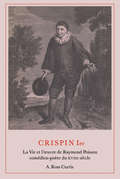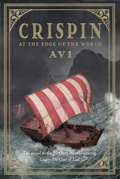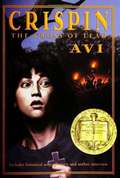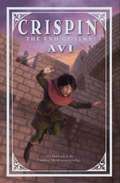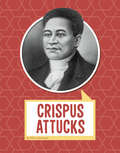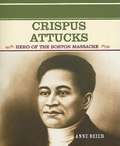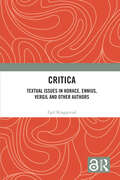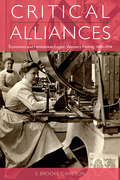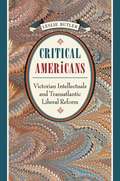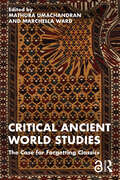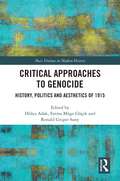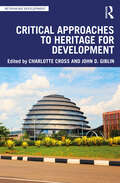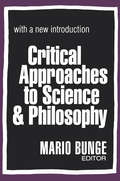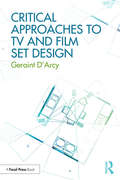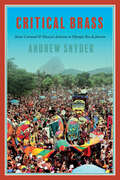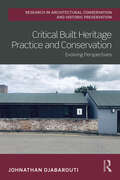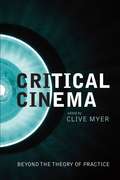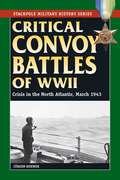- Table View
- List View
Crispien Ier: La Vie et l'œuvre de Raymond Poisson comédien-poète du XVIIe siècle
by A. Ross CurtisRaymond Poisson, a contemporary of Molière, was the leading comic actor with the troupe of the Hôtel de Bourgogne and later at the Comédie Française during the first five years of its existence. He popularized one of the French stage's best-loved stock characters, the impudent servant Crispin, while finding time to supply his troupe with short comedies in which he himself starred. This study is thoroughly documented and reflects the author's detailed knowledge of, and interest in, the period. It establishes Poisson's place in theatrical history, and illuminates a whole tradition in French theatre in the seventeenth century.
Crispin: At the Edge of the World (Crispin)
by AviIn this riveting sequel to the Newbery-Award winning Crispin: The Cross of Lead--the second book in a planned trilogy--Avi explores themes of war, religion, and family as he continues the adventures of Crispin and Bear.The more I came to know of the world, the more I knew I knew it not.He was a nameless orphan, marked for death by his masters for an unknown crime. Discovering his name- Crispin-only intensified the mystery. Then Crispin met Bear, who helped him learn the secret of his full identity. And in Bear-the enormous, red-bearded juggler, sometime spy, and everyday philosopher-Crispin also found a new father and a new world.Now Crispin and Bear have set off to live their lives as free men. But they don't get far before their past catches up with them: Bear is being pursued by members of the secret brotherhood who believe he is an informer. When Bear is badly wounded, it is up to Crispin to make decisions about their future-where to go, whom to trust. Along the way they become entangled with an extraordinary range of people, each of whom affects Crispin and Bear's journey in unexpected ways. To find freedom and safety, they may have to travel to the edge of the world-even if it means confronting death itself.
Crispin: The Cross of Lead (Crispin #1)
by Avi"Asta's Son" is all he's ever been called. The lack of a name is appropriate, because he and his mother are but poor peasants in 14th century medieval England. But this thirteen-year-old boy who thought he had little to lose soon finds himself with even less - no home, no family, or possessions. Accused of a crime he did not commit, he may be killed on sight, by anyone. If he wishes to remain alive, he must flee his tiny village. All the boy takes with him is a newly revealed name - Crispin - and his mother's cross of lead.<P><P> A Newbery Award Winner.
Crispin: The End of Time (Crispin #3)
by AviAs long as I could keep myself out of bondage, I would be true to Bear's teaching. And so it was that beyond all else, I was determined to keep my freedom. After the death of their beloved mentor, Bear, Crispin and Troth are more desperate than ever, wandering the desolate French countryside, where they don't speak the language and know no one. The only hope they cling to is that somehow they can reach Iceland, where Bear had said there were no kings or lords, and where they can live in freedom. Crispin is determined to fulfill this dream, both for himself and to honor Bear's memory. But the road to liberty is filled with danger, betrayal, and loss. Crispin must decide for himself what freedom really means-and how high a price he is willing to pay for it.
Crispus Attucks (Biographies)
by Ellen LabrecqueHow much do you know about Crispus Attucks? Find out the facts you need to know about the first person killed in America's fight for independence. You’ll learn about the early life, challenges, and major accomplishments of this important American.
Crispus Attucks: Hero of the Boston Massacre
by Anne BeierThis book introduces the life of Crispus Attucks, a former slave who died in the Boston Massacre, a fight between the British and American colonists that occurred before the American Revolution.
Criss-Cross: The Making of Hitchcock's Dazzling, Subversive Masterpiece Strangers on a Train
by Stephen RebelloTake a deep dive into the shadows and light of one of the most subversive, corrosively funny, and beloved suspense thriller masterworks as author Stephen Rebello unravels for the very first time the tense and drama-filled story of the making Alfred Hitchcock's Strangers on a Train. As entertaining as it is to watch Strangers on a Train, so too is the previously untold backstory that packs all the suspense, drama, and twists of a thriller. After all, what are the hallmarks of a great Hitchcock movie? A larger-than-life, complex cast of characters, each with something to prove, lose, or hide. Check. Tremendous risk, outsized conflict, and emotion as those men and women confront challenges off the set. Check. Feuds, deceptions, unlikely alliances, and double-crosses. Check. Coming off a 5-year-string of flops, Alfred Hitchcock gambled big on adapting Patricia Highsmith's debut novel, which critics called &“preposterous&” and &“unconvincing," in addition to &“unsavory,&” and &“sick&” (1950s code words for &“gay&” and &“perverted&”). Each step of the production was fraught with battles, but Hitchcock masterfully stayed two steps ahead of his opponents as he fought to bring his vision to life. Strangers on a Train became not only a creative high-water mark and box-office smash for Hitchcock, but also kicked off his unmatched decade of classics including Dial M for Murder, Rear Window, Vertigo, North by Northwest, and Psycho. Richly documented, meticulously researched, and stylishly written, Criss-Cross is more than an authoritative film book. It is a portrait of an especially politically paranoid, misogynistic, and homophobic era in America, a time of dramatic transition in the entertainment industry, and a day of reckoning for Alfred Hitchcock and a few other talents with whom he made a dark, resonant, and prescient work of art.
Cristina: Portraits of a Princess
by Beth Archer BrombertA biography of Cristina, Princess Belgiojoso, noble by birth and an Italian exile, who had a literary salon in 1830s Paris, and wrote about the European political situation.
Critica: Textual Issues in Horace, Ennius, Vergil and Other Authors
by Egil KraggerudGathering together over 60 new and revised discussions of textual issues, this volume represents notorious problems in well-known texts from the classical era by authors including Horace, Ennius, and Vergil. A follow-up to Vegiliana: Critical Studies on the Texts of Publius Vergilius Maro (2017), the volume includes major contributions to the discussion of Horace’s Carmen IV 8 and IV 12, along with studies on Catullus Carmen 67 and Hadrian’s Animula vagula, as well as a new contribution on Livy’s text at IV 20 in connection with Cossus’s spolia opima, and on Vergil’s Aeneid 3. 147–152 and 11. 151–153. On Ennius, the author presents several new ideas on Ann. 42 Sk. and 220–22l, and in editing Horace, he suggests new principles for the critical apparatus and tries to find a balance by weighing both sides in several studies, comparing a conservative and a radical approach. Critica will be an important resource for students and scholars of Latin language and literature.
Critica: Textual Issues in Horace, Ennius, Vergil and Other Authors
by Egil KraggerudGathering together over 60 new and revised discussions of textual issues, this volume represents notorious problems in well-known texts from the classical era by authors including Horace, Ennius, and Vergil.A follow-up to Vegiliana: Critical Studies on the Texts of Publius Vergilius Maro (2017), the volume includes major contributions to the discussion of Horace’s Carmen IV 8 and IV 12, along with studies on Catullus Carmen 67 and Hadrian’s Animula vagula, as well as a new contribution on Livy’s text at IV 20 in connection with Cossus’s spolia opima, and on Vergil’s Aeneid 3. 147–152 and 11. 151–153. On Ennius, the author presents several new ideas on Ann. 42 Sk. and 220–22l, and in editing Horace, he suggests new principles for the critical apparatus and tries to find a balance by weighing both sides in several studies, comparing a conservative and a radical approach.Critica will be an important resource for students and scholars of Latin language and literature.The Open Access version of this book, available at http://www.taylorfrancis.com, has been made available under a Creative Commons Attribution-Non Commercial-No Derivatives (CC-BY-NC-ND) 4.0 license.
Critical Acting Pedagogy: Intersectional Approaches (Routledge Advances in Theatre & Performance Studies)
by Lisa Peck Evi StamatiouCritical Acting Pedagogy: Intersectional Approaches invites readers to think about pedagogy in actor training as a research field in its own right: to sit with the complex challenges, risks, and rewards of the acting studio; to recognise the shared vulnerability, courage, and love that defines our field and underpins our practices. This collection of chapters, from a diverse group of acting teachers at different points in their careers, working in conservatoires and universities, illuminates current developments in decolonising studios to foreground multiple and intersecting identities in the pedagogic exchange. In acknowledging how their positionality affects their practices and materials, 20 acting teachers from the United Kingdom, the United States, Europe, and Oceania offer practical tools for the social justice acting classroom, with rich insights for developing critical acting pedagogies. Authors test and develop research approaches, drawn from social sciences, to tackle dominant ideologies in organisation, curriculum, and methodologies of actor training.This collection frames current efforts to promote equality, diversity, and inclusivity in the studio. It contributes to the collective movement to improve current educational practice in acting, prioritising well-being, and centering the student experience.
Critical Alliances: Economics and Feminism in English Women’s Writing, 1880–1914
by S. Brooke CameronCritical Alliances argues that late-Victorian and modernist feminist authors saw in literary representations of female collaboration an opportunity to produce new gender and economic roles for women. It is not often that one thinks of female allegiances – such as kinship networks, cultural inheritance, or lesbian marriage – as influencing the marketplace; nor does one often think of economic models when theorizing feminist cooperation. S. Brooke Cameron suggest that, through their representations of female partnership, feminist authors such as Virginia Woolf, Olive Schreiner, George Egerton, Amy Levy, and Michael Field redefined the gendered marketplace and, with it, women’s professional opportunities. Interdisciplinary at its core and using a contextual approach, Critical Alliances selects cultural texts and theories relevant to each writer’s particular intervention in the marketplace. Chapters look at how different forms of feminist collaboration enabled women to stake their claim to one of the many, emergent professions at the turn of the century.
Critical Americans
by Leslie ButlerIn this intellectual history of American liberalism during the second half of the nineteenth century, Leslie Butler examines a group of nationally prominent and internationally oriented writers who sustained an American tradition of self-consciously progressive and cosmopolitan reform. She addresses how these men established a critical perspective on American racism, materialism, and jingoism in the decades between the 1850s and the 1890s while she recaptures their insistence on the ability of ordinary citizens to work toward their limitless potential as intelligent and moral human beings.At the core of Butler's study are the writers George William Curtis, Thomas Wentworth Higginson, James Russell Lowell, and Charles Eliot Norton, a quartet of friends who would together define the humane liberalism of America's late Victorian middle class. In creative engagement with such British intellectuals as John Stuart Mill, Thomas Carlyle, Matthew Arnold, Leslie Stephen, John Ruskin, James Bryce, and Goldwin Smith, these "critical Americans" articulated political ideals and cultural standards to suit the burgeoning mass democracy the Civil War had created. This transatlantic framework informed their notions of educative citizenship, print-based democratic politics, critically informed cultural dissemination, and a temperate, deliberative foreign policy. Butler argues that a careful reexamination of these strands of late nineteenth-century liberalism can help enrich a revitalized liberal tradition at the outset of the twenty-first century.
Critical Ancient World Studies: The Case for Forgetting Classics
by Marchella Ward Mathura UmachandranThis volume explores and elucidates critical ancient world studies (CAWS), a new model for the study of the ancient world operating critically, setting itself against a long history of a discipline formulated to naturalise a hierarchical, white supremacist origin story for an imagined modern West. CAWS is a methodology for the study of antiquity that shifts away from the assumptions and approaches of the discipline known as classical studies and/or classics. Although it seeks to reckon with the discipline’s colonial history, it is not simply the application of decolonial theory or the search to uncover subaltern narratives in a subject that has special relevance to the privileged and powerful. Rather, it dismantles the structures of knowledge that have led to this privileging, and questions the categories, ideas, themes, narratives, and epistemological structures that have been deemed objective and essential within the inherited discipline of classics. The contributions in this book, by an international group of researchers, offer a variety of situated, embodied perspectives on the question of how to imagine a more critical discipline, rather than a unified single view. The volume is divided into four parts – “Critical Epistemologies”, “Critical Philologies”, “Critical Time and Critical Space”, and “Critical Approaches” – and uses these as spaces to propose disciplinary transformation. Critical Ancient World Studies: The Case for Forgetting Classics is a must-read for scholars and practitioners teaching in the field of classical studies, and the breadth of examples also makes it an invaluable resource for anyone working on the ancient world, or on confronting Eurocentrism, within other disciplines.
Critical Approaches to Genocide: History, Politics and Aesthetics of 1915 (Mass Violence in Modern History)
by Ronald Grigor Suny Fatma Müge Göçek Hülya AdakThe study of genocide has been appropriate in emphasizing the centrality of the Holocaust; yet, other preceding episodes of mass violence are of great significance. Taking a transnational and transhistorical approach, this volume redresses and replaces the silencing of the Armenian Genocide. Scholarship relating to the history of denial, comparative approaches in the deportations and killings of Greeks and Armenians during the First World War, and women’s histories during the genocide and post-genocide proliferated during the centennial of the Armenian Genocide in 2015. Collectively, however, these studies have not been enough to offer a comprehensive account of the historical record, documentation, and interpretation of events during 1915-1916. This study seeks to bridge the gap, by unsettling nationalist narratives and addressing areas such as aesthetics, gender, and sexuality. By bringing forward various dimensions of the human experience, including the political, socioeconomic, cultural, social, gendered, and legal contexts within which such silencing occurred, the essays address the methodological silences and processes of selectivity and exclusion in scholarship on the Armenian Genocide. The interdisciplinary approach makes Critical Approaches to Genocide a useful resource for all students and scholars interested in the Armenian Genocide and memory studies.
Critical Approaches to Heritage for Development (Rethinking Development)
by Charlotte Cross John D. GiblinThis book investigates the relationship between heritage and development from the global visions articulated by UNESCO and the Sustainable Development Goals (SDGs) to local activism, livelihood innovations and political strategies employed in diverse countries of the Global South. In recent years, as culturally informed approaches to international development have become increasingly important, engaging with heritage has been seen as a way to draw on practices and meanings from the past to help build future development. This book gathers researchers and practitioners from across disciplines to address important themes such as health, the environment, sustainability, peace, security, tourism and economic growth. In doing so, the book asks us to consider whose past and whose future is ultimately at stake in efforts to use heritage for development. Key topics explored include histories and legacies of colonialism and calls for decolonisation, and related questions of expertise, ownership and agency. Students, practitioners and researchers from across the broad areas of history, heritage, education, archaeology, geography and development studies will find this book an invaluable guide to dynamic and contested understandings of heritage and development and the relationship between them.
Critical Approaches to Science and Philosophy
by Mario BungeThis collection of essays, written on four continents by scientists, philosophers and humanists, was initially presented to Karl R. Popper on his sixtieth birthday as a token of critical admiration and in recognition of his work. But the volume also stands on its own as a remarkable series of statements utilizing Popper's critical vision in the study of philosophy proper, logic, mathematics, science as method and theory, and finally to the study of society and history. What is remarkable is that Popper worked in all of these areas, not in a cursory or discursive way, but with the utmost clarity and rigor.. The core position of this volume and its contributors is that the progress of knowledge is not a linear accumulation of definitive acquisitions but a zigzagging process in which counterexamples and unfavorable evidence ruin generalizations and prompt the invention of more comprehensive and sometimes deeper generalizations, to be criticized in their turn. A critical approach to problems, procedures, and results in every field of inquiry is therefore a necessary condition for the continuance of progress.The title of this volume then is, in a sense, an homage to Popper's critical rationalism and critical empiricism. The essays are a tribute to his unceasing and uncompromising quest, not for final certainty, but for closer truth and increased clarity. Among the contributors are outstanding figures in philosophy and the exact sciences in their own right, including Herbert Feigl, R. M. Hare, J.O. Wisdom, Nicholas Rescher, David Bohm, Paul K. Feyerabend, F. A. Hayek, and Adolf Grunbaum. Social science contributions include Hans Albert on social science and moral philosophy, W. B. Gallie, on the critical philosophy of history, Pieter Geyl on The Open Society and its Enemies, and George H. Nadel on the philosophy of History.
Critical Approaches to TV and Film Set Design
by Geraint D'ArcyThe analysis of scenic design in film and television is often neglected, with visual design elements relegated to part of the mise-en-scène in cinema or simply as "wallpaper" in television. Critical Approaches to TV and Film Set Design positions itself from the audience perspective to explore how we watch TV and film, and how set design enhances and influences the viewing experience. By using semiotics, history and narratology and adding concepts drawn from art, architecture and theatre, Geraint D’Arcy reworks the key concepts of set design. Looking at the impact of production design on how the viewer reads film and television, these updated theories can be applied more flexibly and extensively in academic criticism. D’Arcy creates a new theoretical approach, representing a significant expansion of the field and filling the remaining gaps. This book is ideal for anyone interested in understanding how we can read and interpret design in film and television, and should be the primary point of reference for those studying TV and film set design.
Critical Brass: Street Carnival and Musical Activism in Olympic Rio de Janeiro (Music / Culture)
by Andrew SnyderCritical Brass tells the story of neofanfarrismo, an explosive carnival brass band community turned activist musical movement in Rio de Janeiro, as Brazil shifted from a country on the rise in the 2000s to one beset by various crises in the 2010s. Though predominantly middle-class, neofanfarristas have creatively adapted the critical theories of carnival to militate for a more democratic city. Illuminating the tangible obstacles to musical movement building, Andrew Snyder argues that festive activism with privileged origins can promote real alternatives to the neoliberal city, but meets many limits and contradictions in a society marked by diverse inequalities.
Critical Built Heritage Practice and Conservation: Evolving Perspectives (Routledge Research in Architectural Conservation and Historic Preservation)
by Johnathan DjabaroutiCritical Built Heritage Practice and Conservation - Evolving Perspectives supports an alternative point of departure for engaging with the historic built environment, by critically questioning the legitimacy of dominant conservation concepts and methods that are often taken for granted within building conservation, architecture, and adaptive reuse. The meaning of heritage is changing. From pastness to presentness, from preservation to participation, and from tangible to intangible, heritage is increasingly understood as a dynamic, social, and intangible process across many disciplines. Consequently, the role and remit of the built heritage practitioner – and in particular the architectural conservationist – is becoming progressively complex and in need of a critical gaze. Is restoration really a falsehood from beginning to end? Should the condition of existing materials determine the conservation method? Is authenticity really an inherent quality within old buildings? By engaging with a critical interpretation of heritage, this book makes space for practitioners to consider the evolution of their own role within a rapidly changing context of built heritage practice. Reinforced by a shift in emphasis from materials to meanings, a ‘socio-material outlook’ is proposed which champions an enhanced focus on intangible heritage within the built heritage sector, whilst still acknowledging the physical condition of old buildings is a priority for many stakeholders. This book has been written with practitioners, students, and educators of architectural conservation in mind – although will also be of relevance to the broader built heritage industry; as well as academics, researchers, and heritage students with a passion for contemporary dialogues in heritage studies.
Critical Cinema: Beyond the Theory of Practice
by Ed. Myer CliveCritical Cinema: Beyond the Theory of Practice purges the obstructive line between the making of and the theorising on film, uniting theory and practice in order to move beyond the commercial confines of Hollywood. Opening with an introduction by Bill Nichols, one of the world's leading writers on nonfiction film, this volume features contributions by such prominent authors as Noel Burch, Laura Mulvey, Peter Wollen, Brian Winston and Patrick Fuery. Seminal filmmakers such as Peter Greenaway and Mike Figgis also contribute to the debate, making this book a critical text for students, academics, and independent filmmakers as well as for any reader interested in new perspectives on culture and film.
Critical Convoy Battles of WWII
by Jurgen RohwerThe Battle of the Atlantic, the longest continuous campaign of World War II, climaxed in 1943, when Germany came closest to interrupting Allied supply lines and perhaps winning the war. In March of that year, German U-boats scored their last great triumph, destroying nearly 150,000 tons of supplies and fuel.
Critical Crossings: The New York Intellectuals in Postwar America
by Neil JumonvilleThe period immediately following the Second World War was a time, observed Randall Jarrell, when many American writers looked to the art of criticism as the representative act of the intellectual. Rethinking this interval in our culture, Neil Jumonville focuses on the group of writers and thinkers who founded, edited, and wrote for some of the most influential magazines in the country, including Partisan Review, Politics, Commentary, and Dissent. In their rejection of ideological, visionary, and romantic outlooks, reviewers and essayists such as Sidney Hook, Irving Howe, Lionel Trilling, Harold Rosenberg, and Daniel Bell adopted a pragmatic criticism that had a profound influence on the American intellectual community. By placing pragmatism at the center of intellectual activity, the New York Critics crossed from large belief systems to more tentative answers in the hope of redefining the proper function of the intellectual in the new postwar world. Because members of the New York group always valued being intellectuals more than being political leftists, they adopted a cultural elitism that opposed mass culture. Ready to combat any form of absolutist thought, they found themselves pitted against a series of antagonists, from the 1930s to the present, whom they considered insufficiently rational and analytical to be good intellectuals: the Communists and their sympathizers, the Beat writers, and the New Left. Jumonville tells the story of some of the paradoxes and dilemmas that confront all intellectuals. In this sense the book is as much about what it means to be an intellectual as it is about a specific group of thinkers. This title is part of UC Press's Voices Revived program, which commemorates University of California Press’s mission to seek out and cultivate the brightest minds and give them voice, reach, and impact. Drawing on a backlist dating to 1893, Voices Revived makes high-quality, peer-reviewed scholarship accessible once again using print-on-demand technology. This title was originally published in 1991.
Critical Discourse Analysis in Historiography
by John FlowerdewJohn Flowerdew shows how the critical analysis of the evolving discourse employed during a political process spanning more than a decade can provide both insights for discourse analysis and understanding of a real world political process, thereby demonstrating the potential role for critical discourse analysis in historiography, the writing of history. The political process in question is Hong Kong's transition of sovereignty from Great Britain to China. The book analyses the discourse of the outgoing British administration, on the one hand, and the creation of the new discourse of the Special Administrative Region of China, on the other. In addition, the book considers issues of intercultural discourse, where the two competing discourses come into contact and conflict. Individual chapters of the book, in the form of case studies, deal with different communicative events set piece speeches, public meetings, news articles, interviews, and television addresses. "
